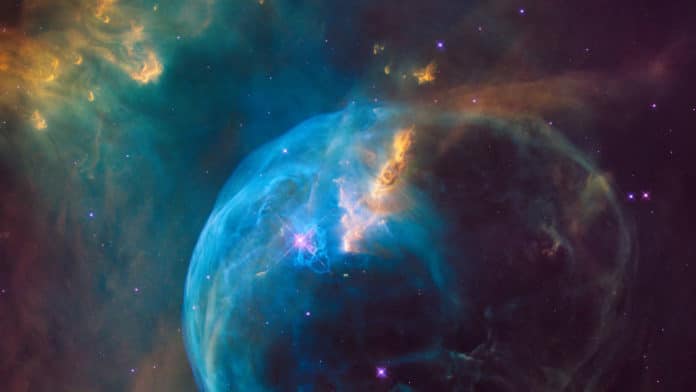Using spectroscopic observations from the W. M. Keck Observatory’s powerful Multi-Object Spectrograph for Infrared Exploration, or MOSFIRE, an international team of astronomers led by scientists at the University of California, Riverside has made detailed measurements of an unusual monster galaxy that existed about 12 billion years ago, when the universe was only 1.8 billion years old.
Dubbed as XMM-2599, this monster galaxy formed stars at a high rate and then became inactive by the time. However, Why it suddenly stopped forming stars is unclear.
Benjamin Forrest, a postdoctoral researcher in the UC Riverside Department of Physics and Astronomy and the study’s lead author, said, “Even before the universe was 2 billion years old, XMM-2599 had already formed a mass of more than 300 billion suns, making it an ultra massive galaxy. More remarkably, we show that XMM-2599 formed most of its stars in a huge frenzy when the universe was less than 1 billion years old, and then became inactive by the time the universe was only 1.8 billion years old.”

Gillian Wilson, a professor of physics and astronomy at UCR in whose lab Forrest works, said, “In this epoch, very few galaxies have stopped forming stars, and none are as massive as XMM-2599. The mere existence of ultramassive galaxies like XMM-2599 proves quite a challenge to numerical models.”
“Even though such massive galaxies are incredibly rare at this epoch, the models do predict them. The predicted galaxies, however, are expected to be actively forming stars. What makes XMM-2599 so interesting, unusual, and surprising is that it is no longer forming stars, perhaps because it stopped getting fuel or its black hole began to turn on. Our results call for changes in how models turn off star formation in early galaxies.”
The study reveals that XMM-2599 formed more than 1,000 solar masses a year in stars at its peak of activity—a very high pace of star arrangement. Conversely, the Milky Way creates around one new star a year.
Danilo Marchesini, an associate professor of astronomy at Tufts University, said, “XMM-2599 may be a descendant of a population of highly star-forming dusty galaxies in the very early universe that new infrared telescopes have recently discovered.”
“The evolutionary pathway of XMM-2599 is unclear.”
Wilson said, “We have caught XMM-2599 in its inactive phase. We do not know what it will turn into by the present day. We know it cannot lose mass. An interesting question is what happens around it. As time goes by, could it gravitationally attract nearby star-forming galaxies and become a shining city of galaxies?”
Co-author Michael Cooper, an associate professor of astronomy at UC Irvine, said, “This outcome is a strong possibility.”
“Perhaps during the following 11.7 billion years of cosmic history, XMM-2599 will become the central member of one of the brightest and most massive clusters of galaxies in the local universe. Alternatively, it could continue to exist in isolation. Or we could have a scenario that lies between these two outcomes.”
Co-author Marianna Annunziatella, a postdoctoral researcher at Tufts University, said, “We identified XMM-2599 as an interesting candidate with imaging alone. We used Keck to characterize better and confirm its nature and help us understand how monster galaxies form and die. MOSFIRE is one of the most efficient and effective instruments in the world for conducting this type of research.”
The team has been awarded more time at the Keck Observatory to follow up on unanswered questions prompted by XMM-2599.
The study results appear in the Astrophysical Journal.
